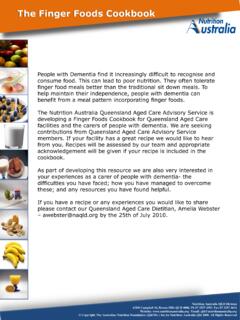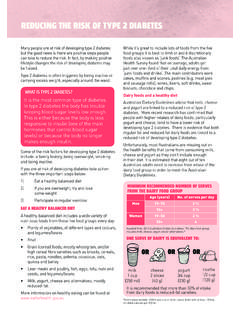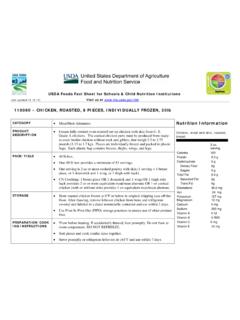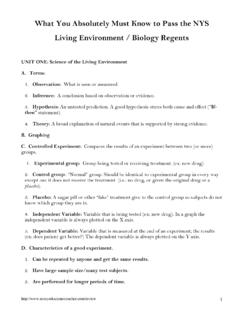Transcription of NUTS AND HEALTH - Nutrition Australia
1 Fact Sheet nuts AND HEALTH . nuts are a healthy plant food because they are high in healthy fats, protein and fibre, yet they're often the source of confusion for those wanting to manage their weight. Lisa Yates, Advanced Accredited Practising Dietitian and Program Manager of nuts for Life answers some of your common questions about nuts below. What are nuts ? 1. According to the Australian Dietary Guidelines , nuts and seeds are: A nut is a simple dry fruit with one or two seeds in which the ovary wall becomes very hard (stony or woody) at maturity, and where the seed remains attached or fused with the ovary include almonds, pecans, walnuts, brazil nuts , cashew nuts , chestnuts, hazelnuts, macadamia nuts , pine nuts and pistachio nuts . The term nut' is applied to many seeds that are not botanically true nuts . These may include cape seed, caraway, chia, flaxseed, linseed, passionfruit, poppy seed, pepita or pumpkin seed, sesame seed and sunflower seed. Although the peanut is technically a legume, the nutritional composition of the peanut is close to that of tree 2,3.
2 nuts , and there is research showcasing peanuts HEALTH benefits . What nutrients do nuts provide? 4. Like other plant foods, nuts provide a range of nutrients , including large quantities of healthy monounsaturated and polyunsaturated fats (49 74% total fat), and moderate amounts of protein (9 20%). (except chestnuts which are low fat). nuts are also a good source of dietary fibre and provide a wide range of essential nutrients, including several B group vitamins (including folate), vitamin E, minerals such as calcium, iron, zinc, potassium and magnesium, antioxidant minerals (selenium, manganese and copper), plus other phytochemicals such as antioxidant compounds (flavonoids and resveratrol) and plant sterols. The 2013 Australian Dietary Guidelines include nuts in the same food group as meat, fish, poultry, eggs and legumes, due to their protein content. A daily serving of 30g is recommended, but an additional 10g of nuts a day can be used in place of 1. other healthy fat foods as well.
3 Each nut variety contains its own unique combination of nutrients and is generally rich in a few nutrients such as: Almonds: protein, calcium and vitamin E. Brazil nuts : fibre and selenium: just two brazil nuts a day provides 100% RDI for selenium for an adult Cashews: non haem (plant based) iron and a low GI rating Chestnuts: low GI, fibre and vitamin C (although much vitamin C is lost during cooking). Produced by Nutrition Australia Victorian Division, August 2014. 2014. The Australian Nutrition Foundation (Victoria) Inc. t/a Nutrition Australia Victorian Division All rights reserved. Hazelnuts: fibre, potassium, folate, vitamin E. Macadamias: highest in monounsaturated fats, thiamin and manganese Pecans: fibre and antioxidants Pine nuts : vitamin E and the arginine amino acid Pistachios: protein, potassium, plant sterols and the antioxidant resveratrol Walnuts: alpha linoleic acid: plant omega 3 and antioxidants nuts are naturally low in sodium, contain potassium and most contain some carbohydrate in the form of natural sugars.
4 Chestnuts are different they are rich in low glycemic index carbohydrates and low in fat making them more like a grain than a tree nut. Is there a nutritional difference between raw and roasted nuts ? There are little differences in the nutrient content of raw and roasted nuts . nuts can be oil or dry roasted, but 5. nuts are so dense they are unable to absorb much oil (approximately 2-5% of the oil they are cooked in) . Roasting does reduce the water content of nuts , concentrating the nutrients, but also reduces the concentration of several B group vitamins as they are not heat stable. While it is possible to buy unsalted, dry roasted nuts . Many oil roasted nut varieties are salted and therefore have a higher sodium content than raw nuts . If you like the taste of roasted nuts , but want to reduce your salt intake, choose unsalted roasted nuts and leave the salted ones for special occasions only. 6,7. Roasting does bring out the flavours of nuts making them nuttier . Are nuts good for heart HEALTH ?
5 Studies suggest that consuming about 30g (a handful) of nuts per day may reduce the risk of developing 8-14 15. heart disease by 30-50% and reduce the risk of death from heart disease by around 20% . This is based on the high proportion of healthy monounsaturated and polyunsaturated fats in nuts , and the low proportion of saturated fats, and the results of studies comparing heart disease rates among people who eat nuts with those who do not. It seems a number of heart-healthy nutrients in nuts work together to achieve this heart protective effect. These include: HEALTH -promoting monounsaturated and polyunsaturated fats that help regulate blood cholesterol Fibre and plant sterols that help reduce cholesterol re-absorption from the gut Arginine (an amino acid which is converted to nitric oxide in the body) which helps keep blood vessels elastic, thereby reducing the risk of atherosclerosis (hardening of the arteries). Antioxidant vitamins and minerals, vitamin E, copper, manganese, selenium and zinc, and other antioxidant compounds such as flavonoids and resveratrol that reduce oxidation and inflammation Naturally low sodium and high potassium levels which assist in maintaining healthy blood pressure.
6 16. Eating an average of 67g of nuts a day can also help improve your cholesterol . nuts and HEALTH 2. Do nuts affect my risk of developing type 2 diabetes? nuts may also help prevent developing type 2 diabetes, although more research is needed. A large study found that women who ate about 30g of nuts per day on five or more days of the week had approximately 30% less risk of developing type 2 diabetes compared 17. with those who ate few or no nuts . This effect was attributed at least partly to the high levels of monounsaturated and polyunsaturated fats found in nuts , which (in addition to their positive effects on blood cholesterol) are believed to enhance insulin sensitivity. A. Harvard meta analysis, which groups together many studies, found a 13% reduced risk of 18. type 2 diabetes when four 30g (approx) serves of nuts are eaten each week . nuts can benefit people with type 2 diabetes, as they help reduce the overall glycemic index of the diet. When added to meals rich in carbohydrate, nuts slow the passage of the meal through the gut and reduce 19-22.
7 Blood glucose levels following the meal and the phytochemicals found in nut skins may slow 23. carbohydrate digestion . nuts can also help reduce the risk of developing Metabolic Syndrome a cluster of metabolic measures that 24,25. if left untreated can lead to type 2 diabetes, heart disease and hypertension (high blood pressure) . Should I avoid nuts if I don't want to gain weight? A small handful of nuts (30 50g) each day is not associated with a weight gain, and may also help reduce 10-13, 26-28. the risk of obesity . The healthy fats in nuts can help you feel fuller, which helps to control 29,30. appetite . And since some fat is trapped in the fibrous structure of the nut, it passes through the body rather than being 30-33. digested . nuts can be part of a healthy diet to maintain or even lose weight, as long as your overall kilojoule intake does not increase. Eating a handful of nuts as a substitute for less healthy foods such as muffins, biscuits, cakes, chips, chocolate and so on.
8 Can I eat nuts in a Mediterranean diet? Including a handful of nuts (30g) every day in a Mediterranean diet or using extra virgin olive oil has more HEALTH benefits than a reduced fat diet. One study found the following: Reduced cardiovascular events (such as myocardial infarction, stroke, and death from cardiovascular causes). A lifetime habit of eating a handful of nuts (30g) more than three times a week resulted in a 39%. reduction in total mortality in an older Mediterranean population at high risk of cardiovascular disease. BMI and waist circumference decreased by and respectively, for each additional serving of nuts eaten. 50% reduction in diabetes incidence, compared to following the low-fat diet over four years. 26% reduction in metabolic syndrome comparing those eating three or more serves of nuts per week with one or fewer serves per week. For more information, download the PREDIMED summary paper at nuts and HEALTH 3. What about nut allergies? Nut allergies are a major concern for a small proportion of the population.
9 People can be allergic to: one or more of the tree nuts (almonds, Brazil nuts , cashews, chestnuts, hazelnuts, macadamias, pecans, pine nuts , pistachios and walnuts). peanuts only both tree nuts and peanuts. For more information on managing tree nut allergy, download this Allergy and Anaphylaxis Australia reviewed fact sheet Other HEALTH benefits of nuts ? Although more research is required, preliminary studies have indicated that nuts may play a role in: . 34-35. Reducing the risk of gall stones . 36. Reducing age-related macular degeneration (which can lead to blindness).. 37. Maintaining bone HEALTH . 38. Slowing brain aging . 15. Reducing cancer risk . How much nuts should I have? A healthy daily intake of nuts is 30g (a small handful) or approximately: 20 almonds 30 pistachio kernels 15 cashews 9 walnut kernels 20 hazelnuts a small handful of mixed nuts or about 15 macadamias two of each of the ten nut varieties 15 pecans (except chestnut which isn't eaten 2 tablespoons of pine nuts raw).
10 Acknowledgements Lisa Yates is an Advanced Accredited Practising Dietitian and Program Manager of nuts for Life, a HEALTH education initiative of the Australia Tree Nut Industry and Horticulture Australia . For more information on including nuts to your diet, visit or follow @nutsforlife on twitter, and pin at nuts and HEALTH 4. References 1. National HEALTH and Medical Research Council (2013) Australian Dietary Guidelines. Canberra: National HEALTH and Medical Research Council. 2. Kris-Etherton PM, Hu FB, Ros E, Sabat J. The role of tree nuts and peanuts in the prevention of coronary heart disease: multiple potential mechanisms. J Nutr. 2008 Sep;138(9):1746S-1751S. 3. Francisco ML, Resurreccion AV. Functional components in peanuts. Crit Rev Food Sci Nutr. 2008 Sep;48(8):715-46. doi: 4. nuts for Life. nuts for Life Nutrient Composition of Tree nuts 2014. 5. Personal communication to the author from members of the Australian Tree Nut Industry. 6. Burdack-Freitag A, Schieberle P.












